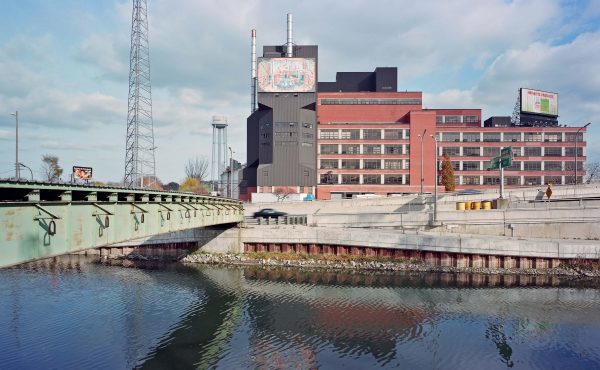
A few months ago, Spacing senior editor Shawn Micallef wrote about the size of the auto factories in his hometown of Windsor. With the help of Sean Galbraith (one of the magazine’s contributors), we compared the relative sizes of those auto plants to Toronto’s downtown grid. We quickly discovered that some of the plants could cover nearly the same area.
So when I passed through the gigantic highway interchange of highways 401 and 427 I thought I’d try a similar exercise. The interchange stretches 2-kilometres wide from Renforth in the west to the on-ramp at Eglinton and the 427 in the east. It is a tanlge of on- and off-ramps as it wraps around the industrial lands of the Molson brewery and Pearson International Airport. The highway gets really wide at this point, roughly 250 metres.
A quick glance of a map of Toronto brings up numerous things to compare the interchange to, but I chose Mount Pleasant Cemetery because it seemed quite similar in orientation and and width (the distance between Yonge and Bayview is 2-kilmotres). Below is a an simple animation overlaying the two maps, going back and forth for comparison.



Probably a little more revealing is switching between satellite images of the two areas. While the occupy a similar amount of space, the lack of quality green space in the interchange is startling .


I also did two other comparions: the 401-Allen Expressway interchange vs. Queen’s Park and the surrounding University of Toronto land (above); and the 401-404-DVP interchange vs. the area around the SkyDome and CN Tower (animated below).




16 comments
Wow, it’s amazing how speed can totally alter your perception of an area. I wonder whether those green spaces could be used by pedestrians, seeing as many of those interchanges are elevated? Maybe a pedestrian overpass is needed?
Wow – thanks for this fascinating look at the urban environment. It should become a regular Spacing department.
Though sadly (I’m being only partly tongue-in-cheek here), I think that I like the DVP/401/400 interchange better than I do the “urban” area around SkyDome!
Thanks for yet another excellent year on Spacing y’all.
There is a cemetery located in the 401-427 intersection. The entrance is via Eglinton Avenue West. See http://maps.google.ca/?ie=UTF8&hq=&hnear=35+Forest+Point+Dr,+Toronto,+Toronto+Division,+Ontario&ll=43.67058,-79.574854&spn=0.002794,0.006968&t=h&z=18 for a look see.
At least some good use is being done, except that the land just north of the cemetery is just grassland. Couldn’t they have some cattle grazing there?
This interesting visual and geographic comparison reminds me of the fascinating work that the Toronto-based Neptis Foundation does with thematic mapping of the GTA. In particular, take a look at their Metropolitan Indicators Poster (under “Atlas”) — a comparison of 16 urban areas around the world, including Toronto, in terms of form, population density and road density (road length per capita).
It really is mind-boggling the area of valuable land that we give over so that cars can wizz along (or sit in traffic). I’m sort of curious how these interchanges compare with a modern highway roundabout.
And on a related note, though I don’t have a reference for this, I remember once reading that all of Renaissance Florence could fit inside one standard cloverleaf highway interchange.
I’ve always wondered why they don’t plant more trees around the dead space around interchanges. I assume it’s because the debris from the trees would be a liability on the road surfaces.
If they want to use space and land efficiently, they should put the freeway interchange over top of the cemetery. The residents of the cemetery probably won’t complain.
Andrew: Do you know is there is a high resolution version of the Metropolitan Indicators Poster anywhere on the internet? I’d really like to see it but the version on the Neptis website is very low resolution.
Fascinating analysis.
NB: that’s the 401-Allen Rd interchange, not 401-400. (You’re forgiven.)
Driving that stretch of Highway makes one cringe. Always slow, always backed up, usually an accident.
I wish you had made the comparison to a built up area or neighbourhood so I could get some idea of what could go there instead, how many people might be able to live there, etc. That’s part of what I think gave the auto plant comparisons such an impact.
The area around Mt. Pleasant Cemetery and Queens Quay are built up neighbourhoods. Maybe not your neighbourhood, but they are established Toronto ‘hoods.
Tessa, surely you would agree that part of a great city is the ability to move goods and people efficiently?
Major transportation interchanges, whether they are highway crossings, seaports, airports or railway marshalling yards, always take up enormous amounts of land. The latter is a good case in point: for decades we have been developing several neighbourhoods of tens of thousands of people on the former rail lands to the east and west of downtown.
Chris, it’s worth emailing Neptis and ordering a copy of the printed version of their study, which is poster-sized. This foundation has done some tremendous spatial analysis of the Toronto city region.